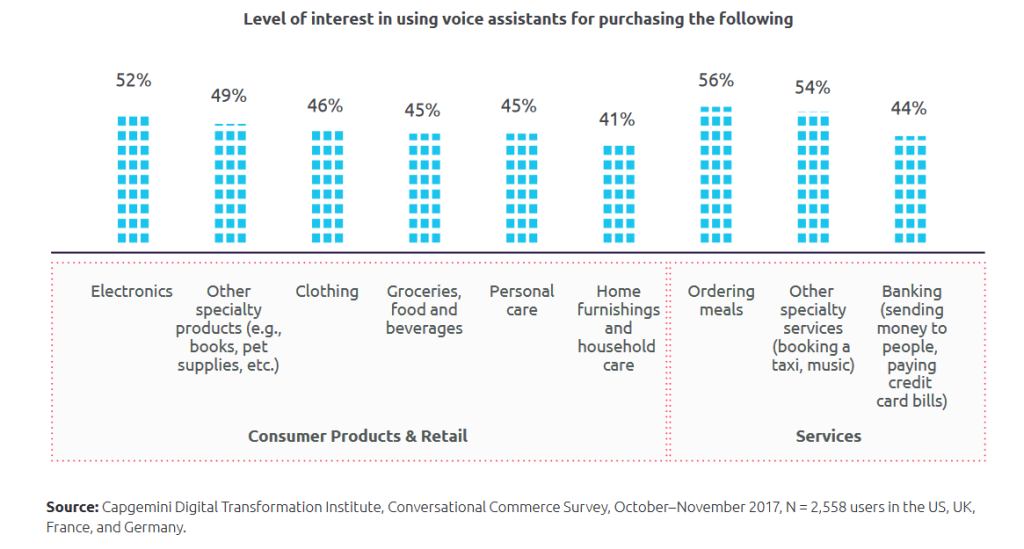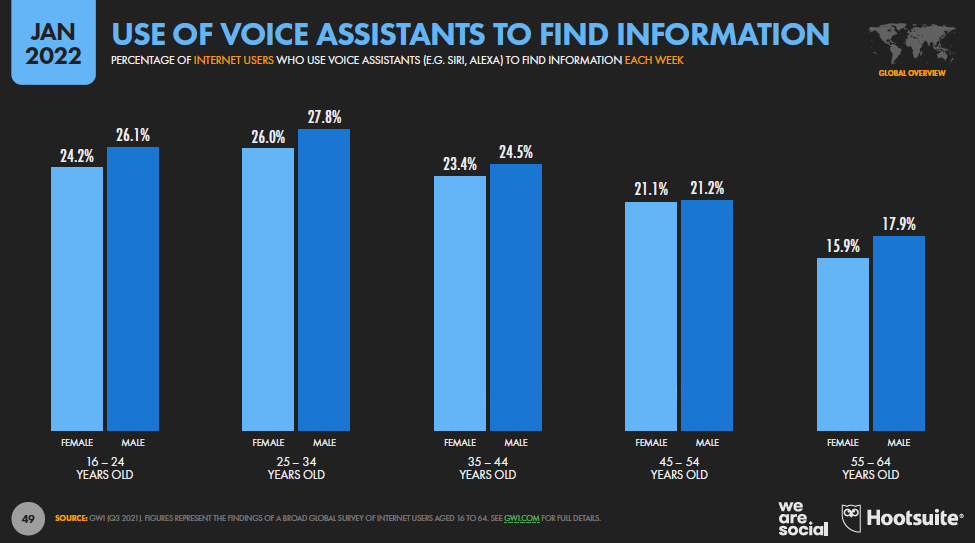Going from/to the office, switching from one device to another, shopping for groceries… the daily frenzy made it hard to remember not only doing something but even typing it on a phone.
Then Covid came, and consumer patterns were suddenly shattered, at least temporarily. The new normal suddenly unveiled a new need: making it easier for consumers to keep nurturing the economy without the risk of contagion: leaving stores quickly, avoiding them at all, or ordering online for pick up or delivery are new forms of consumption that have accelerated the rise and democratization of voice and speech recognition.
Ecommerce is about to see the start of a revolution in how people communicate, plan, and create new consumption patterns.
And at Content2Sell we believe this will have an impact on certain product categories.
How we use voice search
7 billion voice messages are sent daily on WhatsApp.
If you think about it, people speak an average of 125-150 words per minute, and typing those words usually takes about three times as long. Whether you are cooking, driving, or simply getting ready to go, voice allows running hands-free queries and commands in an intuitive, informal, and seamless way. Whether you only have a phone, or you have equipped your home with smart speakers, hyperconnectivity allows you to centralize your daily tasks and thoughts.
In 2018, Cap Gemini ran a Conversational Commerce study among 5000 people in the US, with some quite revealing insights:
- 40% of consumers prefer using a voice assistant instead of a mobile app or a website.
- 81% of users used them on smartphones.
- 25% from a smart speaker.
- 35% used them to buy groceries, home care products, or clothes
- 28% made a payment or sent money
- 28% booked an Uber or any taxi service
Things get interesting when you see an astonishing 56% of respondents are interested in being able to purchase other products, such as consumer electronics.

When asked about what features they value the most in voice assistants, consumers focus mostly on:
- 82% say fast and accurate replies
- 81% say understanding diction and accent
- 75% the relevancy of recommendations.
Users are always driven mainly by two things: price and convenience, and the price has little to do with voice shopping. What actually drives someone to shop using their voice assistants is how convenient it is to shop while doing other tasks that either require hands, presence, or attention. When asked why they prefer voice shopping to retail, users say voice assistants are both fast and convenient, which prevails upon price.
And, objectively speaking, using voice search in ecommerce has a bunch of benefits:
- Saves time
- No need for screens, typing hardware, or interfaces, which overcomes the limitations of having your hands busy.
- Natural communication.
- Ubiquity. You can give commands anywhere, at any time.
The growth of voice search in ecommerce
With this data in hand and the hybridization that is defining the future of ecommerce, we can say voice assistants are indeed about to revolutionize online commerce.
Kiril Petrov, CEO of Just-AI.com states that in 5 to 10 years voice assistants, chatbots, and conversational AI, in general, will be deeply integrated into our everyday life, reaching up to 41 billion users worldwide.
The reason is simple: voice is a natural interface that can be processed and understood. The current development of NLU (Natural Language Understanding) and NLP (Natural Language Processing) is already in the pilot phase for progressive implementation.
It’s a matter of time until we see direct integrations with online businesses.
Integrations
Microtasks like alarms, reminders, schedule organization and quick searches are a daily occurrence. So is connectivity across devices through a single virtual assistant. But more integrations are necessary to talk not only to devices but to brands. Say, for example, adding products to your online supermarket cart or automating the ordering of consumables for other connected products.
In this regard, Google has been working with Walmart, Petsmart, Sephora, and Home Depot to develop branded conversational capabilities and experiences that can be ordered with a simple voice command.
This is already a reality. For example, an increasing implementation in cars and new construction houses, yet further integrations and partnerships are to come. Nevertheless, many other companies are working on AI applied to conversational commerce, like RAIN, an essential actor in Alexa’s deep learning.
Seamlessness and multimodality
More, and smarter devices become part of our daily lives: phones, smartwatches, speakers, fans, lamps, and even curtain openers. Devices with microphones allow centralizing all of our commands in a single profile.

Apple got this right from the very first beginning, back in 2011. Siri had just been launched, as a multimodal assistant able to have natural conversations, understand contexts, and work seamlessly across built-in apps.
Not long after, in 2014, Amazon launched Echo, the first smart speaker with computer capabilities solely designed to work with voice commands. Today, a simple phone app allows the creation of this expansive connected ecosystem.
Google on its side, uses Device Access Management to create smart homes controlled by any connected device: phones, tablets, speakers, or tvs. In fact, Samsung devices also use this technology powered by Google.
Again, devices may vary, but voice assistants are Google, Amazon, and Apple, and it is through integrations and partnerships that voice assistants will finally take off.
Adapting your business to voice search
The main objective of voice is to save time and live better (Dominique Essig, Walmart’s VP of Conversational Commerce). Search engines (and virtual assistants) have a clear role in providing users with what they are looking for. And a crucial aspect of reaching consumers is knowing everything about them. Specifically, when your product solves a given need. As usual, user research is essential.
SEO
Because we write differently than we talk, the irruption of smart voice assistants and deep learning has also changed how voice search is understood. This in turn interferes with one of the main elements in online marketing: keywords.
The keyword bid market is used to match search intents and search results through algorithms. Algorithms that are based on big data and user behavior. Thus, when users talk in a casual tone instead of typing, machine learning must necessarily adapt to it.
- Adapt your SEO to vocal searches, so search engines can easily identify your products.
- Do bid on keywords that include pain points.
Photography
Voice and sight may be different senses, but image creates an immediate impact. It takes you to the right place at the right time.
A quick search calls for quick results. In other words, a solution to a problem. And when users search for a specific product, instant visual recognition instead of words and descriptions. They will be more likely to look for more information and click your ad if their first impression matches their query.
- Show your product in a general shot so there is no confusion. Remember a click on your ad has a cost but doesn’t always result in a sale.
- When multiple images are allowed, show it in action and highlight its top-selling features in the clearest possible way.
There’s still a lot to see
Since the first release of Siri, back in 2011, voice assistants have had their ups and downs, failing sometimes to fulfill expectations. But Machine Learning is a slow process working with algorithms that need adjustments and integrations to overcome their limitations.
Nevertheless, Artificial Intelligence is already among us and provides very useful services, ranging from helping us organize our daily lives, to providing chatbot customer support.
Of course, not all products will see their sales increase with the implementation of voice assistants in ecommerce. That will depend on their category and, yes, their price – the risk perception.
These are clear signs that voice assistants in ecommerce are about to change the communication between consumers and brands. Adapting to this opens vast opportunities for businesses that understand that consumers prefer to have a type of contact that gets as human as possible, saves time, and doesn’t interrupt when inputting information.



